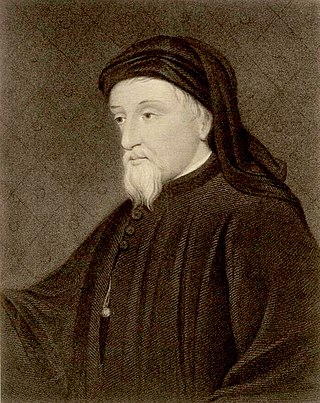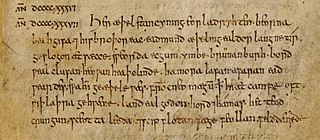Related Research Articles

Geoffrey Chaucer was an English poet, author, and civil servant best known for The Canterbury Tales. He has been called the "father of English literature", or, alternatively, the "father of English poetry". He was the first writer to be buried in what has since come to be called Poets' Corner, in Westminster Abbey. Chaucer also gained fame as a philosopher and astronomer, composing the scientific A Treatise on the Astrolabe for his 10-year-old son Lewis. He maintained a career in the civil service as a bureaucrat, courtier, diplomat, and member of parliament.

In prosody, alliterative verse is a form of verse that uses alliteration as the principle ornamental device to help indicate the underlying metrical structure, as opposed to other devices such as rhyme. The most commonly studied traditions of alliterative verse are those found in the oldest literature of the Germanic languages, where scholars use the term 'alliterative poetry' rather broadly to indicate a tradition which not only shares alliteration as its primary ornament but also certain metrical characteristics. The Old English epic Beowulf, as well as most other Old English poetry, the Old High German Muspilli, the Old Saxon Heliand, the Old Norse Poetic Edda, and many Middle English poems such as Piers Plowman, Sir Gawain and the Green Knight, and the Alliterative Morte Arthur all use alliterative verse.

Medieval literature is a broad subject, encompassing essentially all written works available in Europe and beyond during the Middle Ages. The literature of this time was composed of religious writings as well as secular works. Just as in modern literature, it is a complex and rich field of study, from the utterly sacred to the exuberantly profane, touching all points in-between. Works of literature are often grouped by place of origin, language, and genre.

Flyting or fliting, is a contest consisting of the exchange of insults between two parties, often conducted in verse.

The canto is a principal form of division in medieval and modern long poetry.

Walter William Skeat, was a British philologist and Anglican deacon. The pre-eminent British philologist of his time, he was instrumental in developing the English language as a higher education subject in the United Kingdom.
"Sir Thopas" is one of The Canterbury Tales by Geoffrey Chaucer, published in 1387. The tale is one of two—together with The Tale of Melibee—told by the fictive Geoffrey Chaucer as he travels with the pilgrims on the journey to Canterbury Cathedral. The tale concerns the adventures of the knight Sir Thopas and his quest to win the elf-queen.

The Heliand is an epic poem in Old Saxon, written in the first half of the 9th century. The title means healer in Old Saxon, and the poem is a Biblical paraphrase that recounts the life of Jesus in the alliterative verse style of a Germanic epic. Heliand is the largest known work of written Old Saxon.
Thomas Chestre was the author of a 14th-century Middle English romance Sir Launfal, a verse romance of 1045 lines based ultimately on Marie de France's Breton lay Lanval. He was possibly also the author of the 2200-line Libeaus Desconus, a story of Sir Gawain's son Gingalain based upon similar traditions to those that inspired Renaut de Beaujeu's late-12th-century or early-13th-century Old French romance Le Bel Inconnu, and also possibly of a Middle English retelling of the mid-13th-century Old French romance Octavian. Geoffrey Chaucer parodied Libeaus Desconus, among other Middle English romances, in his Canterbury Tale of Sir Thopas.
Tail rhyme is a family of stanzaic verse forms used in poetry in French and especially English during and since the Middle Ages, and probably derived from models in medieval Latin versification.
"The Tale of Melibee" is one of The Canterbury Tales by Geoffrey Chaucer.
The term Middle English literature refers to the literature written in the form of the English language known as Middle English, from the late 12th century until the 1470s. During this time the Chancery Standard, a form of London-based English became widespread and the printing press regularized the language. Between the 1470s and the middle of the following century there was a transition to early Modern English. In literary terms, the characteristics of the literary works written did not change radically until the effects of the Renaissance and Reformed Christianity became more apparent in the reign of King Henry VIII. There are three main categories of Middle English literature, religious, courtly love, and Arthurian, though much of Geoffrey Chaucer's work stands outside these. Among the many religious works are those in the Katherine Group and the writings of Julian of Norwich and Richard Rolle.
Michael Joseph Alexander is a British translator, poet, academic and broadcaster. He held the Berry Chair of English Literature at the University of St Andrews until his retirement in 2003. He is best known for his translations of Beowulf and other Anglo-Saxon poems into modern English verse.
Layamon's Brut, also known as The Chronicle of Britain, is a Middle English poem compiled and recast by the English priest Layamon. Layamon's Brut is 16,096 lines long and narrates the history of Britain. It is the first historiography written in English since the Anglo-Saxon Chronicle. Named for Britain's mythical founder, Brutus of Troy, the poem is largely based on the Anglo-Norman French Roman de Brut by Wace, which is in turn a version of Geoffrey of Monmouth's Latin Historia Regum Britanniae. Layamon's poem, however, is longer than both and includes an enlarged section on the life and exploits of King Arthur. It is written in the alliterative verse style commonly used in Middle English poetry by rhyming chroniclers, the two halves of the alliterative lines being often linked by rhyme as well as by alliteration.
The thula is an ancient poetic genre in the Germanic literatures. Thulas are metrical name-lists or lists of poetic synonyms compiled, mainly, for oral recitation. The main function of thulas is thought to be mnemonic. The Old Norse term was first applied to an English poem, the Old English "Widsith", by Andreas Heusler and Wilhelm Ranisch in 1903. Thulas occur as parts of longer poems, too; Old Norse examples are found in various passages of the poetic and the prose Edda, the Rígsþula as well as in the Völuspá. Thulas can be considered as sources of once canonic knowledge, rooted in prehistoric beliefs and rituals. They generally preserve mythological and cosmogonical knowledge, often proper names and toponyms, but also the names of semi-legendary or historical persons. Their language is usually highly formalized, and they make extensive use of mnemonic devices such as alliteration. For a number of archaic words and formulas, some thulas are the only available source. The term and the genre may go back to the function of the Thyle, who held the function of an orator and was responsible for the cultus.

Contact between Geoffrey Chaucer and the Italian humanists Petrarch or Boccaccio has been proposed by scholars for centuries. More recent scholarship tends to discount these earlier speculations because of lack of evidence. As Leonard Koff remarks, the story of their meeting is "a 'tydying' worthy of Chaucer himself".
Siege of Thebes is a 4716-line poem written by John Lydgate between 1420 and 1422. Lydgate composed the Siege of Thebes directly following his composition of Troy Book - which was patronized by King Henry V - and directly preceding his production of The Fall of Princes - which Humphrey Duke of Gloucester patronized during King Henry VI's regency. The poem is particularly significant because it was written without an identifiable patron, and most probably without patron or commission whatsoever. Whatever the status of its patronage, the Siege of Thebes still managed to gain significant popularity, attested to by its 31 surviving manuscripts. The poem is, in large part, a response to Geoffrey Chaucer's The Canterbury Tales. Lydgate's poem borrows The Canterbury Tales' pilgrimage-based framing device and is written as an additional tale in the cycle. However, unlike Chaucer, Lydgate establishes himself as the narrator of the work, and recounts the siege of Thebes. Lydgate's Siege of Thebes follows and expands upon the Theban Cycle, but makes significant additions to the source materials.
Sir Perceval of Galles is a Middle English Arthurian verse romance whose protagonist, Sir Perceval (Percival), first appeared in medieval literature in Chrétien de Troyes' final poem, the 12th-century Old French Conte del Graal, well over one hundred years before the composition of this work. Sir Perceval of Galles was probably written in the northeast Midlands of England in the early 14th century, and tells a markedly different story to either Chretien's tale or to Robert de Boron's early 13th-century Perceval. Found in only a single manuscript, and told with a comic liveliness, it omits any mention of a graal or a Grail.
The Lincoln Thornton Manuscript is a medieval manuscript compiled and copied by the fifteenth-century English scribe and landowner Robert Thornton, MS 91 in the library of Lincoln Cathedral. The manuscript is notable for containing single versions of important poems such as the Alliterative Morte Arthure and Sir Perceval of Galles, and gives evidence of the variegated literary culture of fifteenth-century England. The manuscript contains three main sections: the first one contains mainly narrative poems ; the second contains mainly religious poems and includes texts by Richard Rolle, giving evidence of works by that author which are now lost; and the third section contains a medical treatise, the Liber de diversis medicinis.

The "Battle of Brunanburh" is an Old English poem. It is preserved in the Anglo-Saxon Chronicle, a historical record of events in Anglo-Saxon England which was kept from the late ninth to the mid-twelfth century. The poem records the Battle of Brunanburh, a battle fought in 937 between an English army and a combined army of Scots, Vikings, and Britons. The battle resulted in an English victory, celebrated by the poem in style and language like that of traditional Old English battle poetry. The poem is notable because of those traditional elements and has been praised for its authentic tone, but it is also remarkable for its fiercely nationalistic tone, which documents the development of a unified England ruled by the House of Wessex.
References
- ↑ 'fit | fytte, n.1.', Oxford English Dictionary Online, 1st edn (Oxford: Oxford University Press, 1896).
- ↑ R. D. Fulk, 'The Origin of the Numbered Sections in Beowulf and in Other Old English Poems', Anglo-Saxon England, 35 (2006), 91–109 (p. 91 fn. 1).
- ↑ B. J. Timmer, 'Sectional Divisions of Poems in Old English Manuscripts', The Modern Language Review, 47 (1952), 319–22 (pp. 320–21).
- ↑ J. A. Burrow, '"Sir Thopas": An Agony in Three Fits', The Review of English Studies, vol. 22, no. 85 (February, 1971), 54–58.
- ↑ E. A. Jones, '"Loo, Lordes Myne, Heere Is a Fit!": The Structure of Chaucer's Sir Thopas', The Review of English Studies, new series, vol. 51, no. 202 (May, 2000), 248–52.